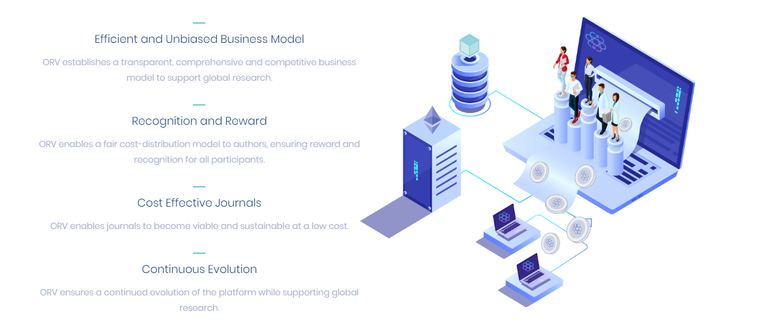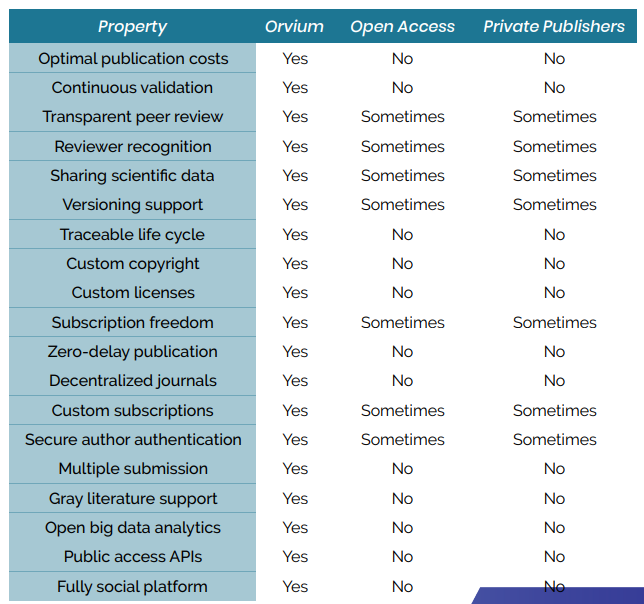INTRODUCTION TO ORVIUM :
The scientific publishing industry is one of the most profitable in the world. The top five publishers account for 50% to 70% of all publications, and their profit margins have been reported to exceed those of companies such as Google, Amazon and Apple. In 2015, the global market for scientific, technical, and medical (STM) publications was an estimated $25 billion.
Orvium Mission
Orvium works to eliminate market inefficiencies and improve the quality and effectiveness of scientific publishing. The ultimate objective is for Orvium to be the leading publication platform for the research community while returning the benefits of science to the society

Orvium Solution
Orvium leverages a unique and seamless integration of cutting-edge technologies: Ethereum blockchain and smart contracts, decentralized storage solutions, big data analytics, and cloud computing, to create a platform to process, validate, and disseminate research data and results.
Business Model and Orvium Token (ORV)
Orvium establishes a transparent, comprehensive and competitive business model to obtain and increase revenue while supporting global research. Orvium’s business model is built on the Orvium token (ORV), a new digital cryptocurrency created specifically for the platform.

Market Overview
Market Opportunity
In 2015 there were an estimated 9 million active researchers. They published between 1.8 and 2 million articles per year, which collectively produced more than 2.5 billion full-text downloads from STM publishers’ websites, plus perhaps another 400 million from other sites. These numbers grow by 3 to 3.5% yearly and do not 6 consider open access models which represent an important percentage. To give context on those numbers, 3 billion downloads is the total number of apps downloaded from iTunes Apple store during its first 3 years of existence or half of 7 the songs downloaded yearly from the same source .
Market Entry Barriers
The nature of the current publishing system introduces important market entry barriers to new disrupting entities. Those arise from different false perceptions 13 promoted by the existing industry and is associated with different factors:
Social and scientific factors:
– Fear of ideas being stolen or not being properly credited.
– Fear of reputational risks from trying new things.
– Lack of trust in citizen science, perception of lower quality.
– Established researchers are less likely to change.
– Perception of the impossibility to establish a fair benefits system for researchers for sharing data or making papers accessible.
Technological factors:
– Unnecessary idea, forced by the industry, requiring long-term investment in digital infrastructure for storing data and publications.
– Lack of integrated data infrastructure across disciplines and organizations.
Policies and costs factors:
– Perception that open science activities, such as preparing data for sharing, are time-consuming.
– Opaque decisions about fees and policies that are driven by private interest rather than public good. – Current forced copyright and licensing model perceived as the only viable option.
Orvium Market Entry Strategy
Orvium introduces an efficient and simple strategy to overcome market entry barriers. The strategy is based on promoting open and transparent access to scientific knowledge while supporting the required technological evolution.
Copyrights and Licenses Owned by Publishers
With traditional publishers, copyright under the current intellectual property rights regime is enforced by the owners of the journal. Authors grant copyright to exploit their content commercially without any retribution. In theory, the permission is granted in return for services provided, such as editing, peer review, publishing and advertising. However, a large proportion of the editing and peer review costs are already paid or done on a voluntary basis by the research community.
Low Quality Journals and Predatory Practices
Alarmingly, during the last several years, fake and low-quality journals have proliferated. According to Beall’s list , the number of predatory journals doubles 22 every 2 years and the number of articles appearing in them has exploded, reaching more than half a million low-quality articles per year . This trend is driven by 23 increasing numbers of researchers (2%–3% annually) who need to publish in order to access grants and obtain recognition and awards leading to career advancement.
The Orvium Disruption
“Nothing is more powerful than an idea whose time has come.” - Victor Hugo.
Orvium disrupts the current publication business model by establishing a decentralized and competitive market, separate from the current oligopoly, to manage the life cycle of research publications. The idea is simple: authors and research institutions hold the copyright and the license for use of their publications. They are free to establish the terms and prices for the rights to print, redistribute, download, translate or re-use the publications.
Community Driven Journals and Governance Rules
Orvium is agnostic regarding the definition of governance rules, and its mission is to empower Orvium’s community with a framework that defines the governance rules that best fulfil the requirements of each specific DAJ case.
The governance rules are enforced by Smart Contracts. The governance rules are a key aspect of the process in that they make up the framework that allows DAJ owners to set agreements regarding the operation of the journals in fields such as licensing or subscription-based models, which content to publish, and agreements with authors or third-parties.
Publication Model Comparison
The following table summarizes Orvium advantages and the current industry model:

Orvium Business Model and Token Mechanics
The ultimate objective is for Orvium to become the leading platform for researchers, research institutions and scientific editors to manage the life cycle of scholarly publications. Orvium offers numerous advantages to accomplish this goal, while drastically reducing the costs associated with publication, thanks to its global decentralized platform.
LINK MORE INFORMATION
TWITTER || FACEBOOK || TELEGRAM || WHITEPAPER || WIBESITE ||